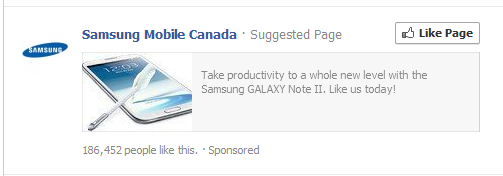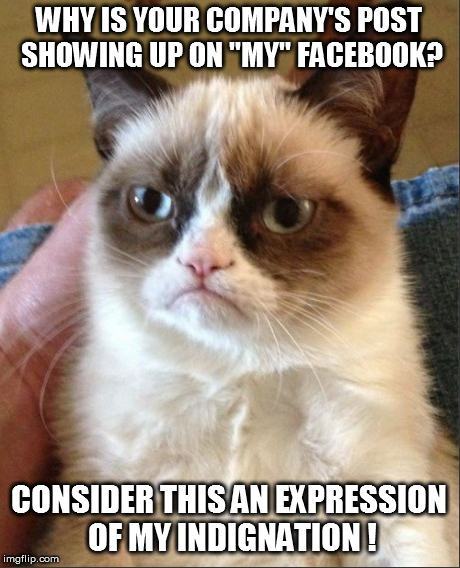Why buy hate on Facebook?
In a previous Roo blog, I lamented at the walled garden approach social networks are starting to take. It was highlighted by Instagram and Twitter refusing to play nice with each other and Twitter's increasingly unfriendly attitude towards third party Twitter clients. Profits, elusive profits, are the driver of these wagon-circling moves. Web 2.0, as it turns out, is a lot like Web 1.0. These companies are great at getting numbers but pretty lousy at monetizing.

Inattentional Blindness. Most radiologists never noticed the dancing gorilla in this CT scan.
Facebook is ad supported. Facebook provides an excellent service and they are more than welcome, in my opinion, to run all manner of ads. There's an interesting psychological phenomenon called Inattentional Blindness. When we concentrate on something, it's very easy for us to miss not just the mundane around us but something like a gorilla walking into your field of vision, dancing, and walking off. In the online world, we're learning how to ignore ads. This is a huge problem for Facebook which makes a lot of money if you notice the ads the site runs along the side and you click through them on occasion. The Facebook layout, unfortunately, works against it. The ads are in a channel on the right. The "meat", the newsfeed, is in the middle.
Facebook, Promoted Posts, and Grumpy Cats
Facebook has, lately, been trying to inject promotional material into the newsfeed. Old hands will remember the early days of search engines (circa early 2000s) and controversies over paid inclusions in search results. Inktomi (aka hotbot), Askjeeves, and Overture (aka goto.com) were some of the search engines that tried and failed miserably building a business model around paid inclusion. Google, MSN (now Bing), and Yahoo clued in paid inclusion made users question the impartiality of results and wisely took steps to clearly delineate between organic results and paid results.
Facebook has lately been selling space on "your" newsfeed. The promoted posts seemed to, at first, start showing up as a kind of "Your friend X liked this company… here's one of their recent posts" type inclusions. You had to look fairly closely to determine it wasn't something your friend specifically shared. Recently Facebook seems to have done away with the ambiguity and just injects promoted posts into your newsfeed.

I've not seen these promoted posts wildly abused via my own newsfeed. I had to scroll back pretty far in my timeline (sorry boss!) to find an ad by Samsung. HOW. DARE. THEY.
And just as Inattentional Blindness makes Facebook sidebar ads a hard sell, the phenomenon of unintended consequences also troubles Facebook's new revenue model. When such ads pop up, there's a trend to slag the business in the post's comment section. You might wonder, why some business are paying money to generate so much hate? Technically, the angry commenters are not really hating on the business. They're rebelling against what they view as a violation or ignorance of the user's permission (or lack thereof) to be engaged in this way.
Social network users are fickle. These are the same people who don't mind their cell phones and debit cards pretty much track their movements and vast range of highly personal behaviors. But if Facebook lets Bob's Burgers know you like fast food. Well, HOLY HELL, you've got an uprising on your hands. Pray you do not become the target of a Grumpy Cat meme.
What tacit permissions do your customers grant you?

Surely, you and your business are not Facebook. No one would ever mount a withering Grumpy Cat meme attack against you. Well, maybe. An important lesson to learn is there can be a gap between the tacit permissions your customers think they have given you and the permissions you think you have to engage and promote.
At BlueCamroo, there's a very fine line we have to walk between keeping users informed of critical updates and not making it seem like we're unnecessarily spamming them with fluff. I don't mind a weekly email from Old Navy telling me when their cargo pants are 30% off. (Yeah, cargo pants. Sue me. I work in software.) However, I really hated when the Canadian department store The Bay used my email address to send me three promo emails a day.
The danger of unknowingly violating these kind of unspoken permission thresholds is all your email gets filtered out, including the really important things like down times, major changes, new contract terms, etc.
The most obvious way to avoid this pitfall is create an opt-in relationship from the outset. Ensure emails have a conspicuous unsubscribe link that works and removes a person from a mailing list immediately. Get a feel for why clients are unsubscribing with a short survey. I know when I finally unsubscribed to the department store's mailing I was very happy to find an exit survey and could clue them in that their strategy was highly counterproductive.
If you're a very small business, this kind of technological solution might be beyond your means. You've got a simple web site, a blog, and a mail list. You should first look into the costs of doing it right. Some costs are unavoidable. Yes, that hockey equipment is expensive but it takes just one puck to ruin your fun. The Internet makes it very inexpensive to engage clients but there is a cost of doing business right and cost to doing it wrong.
At a minimum, leverage your passive social channels to gauge your customer's permissions. If you have a company page on Facebook, use the survey tool to poll your clients about the level of engagement they're comfortable with. Just never assume because people are okay with X (e.g. the relationship people have with their wireless carrier) therefore Y (your relationship with them) is similar and people will be okay with it.
